Thursday, April 8, 2010
Finally...
I also get to try out my new camera on this trip. Hoping to get some great photos.
This trip will add 4 new states to my states I've been to list. After this I'll have 12 states I haven't been to:
Alaska
Arkansas
Hawaii
Kentucky
Michigan
Minnesota
Oklahoma
South Dakota
Tennesee
Vermont
Wisconsin
My plan is to update this blog with the details of our trip. Hopefully I can post some photso as well. So at the end of this month check back to see updates.
Sunday, October 11, 2009
Someone please explain this...
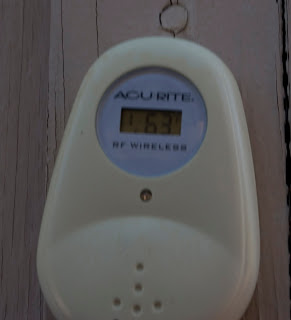
As you can see it is 63º F outside. A nice decent temperature. Inside our house it's a little stuffy, around 73 degrees, so I have the windows open to enjoy the nice fresh air. And so it will cool down a little bit in here.
Except the air is not all that fresh. This next photo was taken about 20 seconds after the above photo. It's the house on the street behind our house.
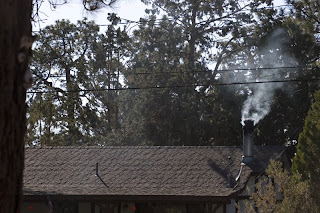
Please someone explain why one would need to burn in thier fireplace when it is 63º? And for that matter, why people can't burn dry wood, instead of green evergreen wood that smokes like this. Every night we have to shut our windows because of this. There are times it's so hot and stuffy in the house, I need to run an Air Conditioner, even though it's in the 50's outside.
Wednesday, September 30, 2009
Busy, Busy, Busy
What I'm hoping to do is post more often. Yesterday I posted about one of my favorite photographs, so I think I may continue doing that. Hope to see you back here.
Tuesday, September 29, 2009
My best (Water)Fall photo ever...
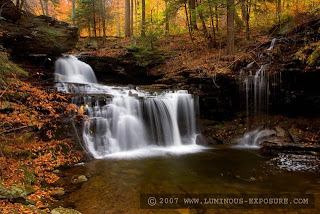
Sunday, September 27, 2009
Eastern Sierra Fall Color Report 9-26-09
But by far the worse thing I saw was a woman driving a Ford Taurus wagon almost running over a pedestrian. Just below Lake Sabrina, 2 female photographers pulled over on the one side of the road near a bridge. When one of them was crossing the street, the driver in the taurus doing about 30-40mph came up behind her. Instead of slowing down, they floored the gas as they went around the pedestrian, scaring her because she couldn't hear the car comming. So watch yourselves out there.
Ok onto the report. My trip started out friday night (Sept 25) when we drove up to Eastern Sierras from Big Bear Lake. I decided we'd camp in Rock Creek area. So we drove up Rock Creek Road. All of the smaller campgrounds were full, so we stayed at East Fork, which was less then half full. Next morning we woke up at 5am and drove to North Lake in Bishop Creek Canyon. Most of my best photos were in this area. I'd say most of the trees are near peak or peak here. There are still some green trees around, but all and all I'd say it's good here.
The sunrise was great.
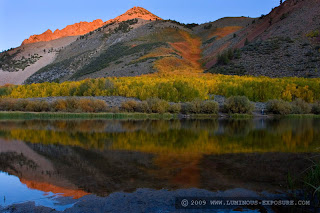
As the sun came up farther in the sky, it lit up the area. And I took this panoramic.
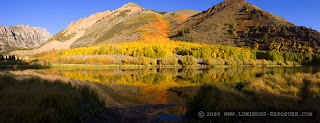
This is from a meadow near North Lake.
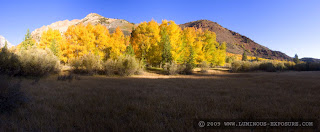 The road from North Lake to the campground.
The road from North Lake to the campground.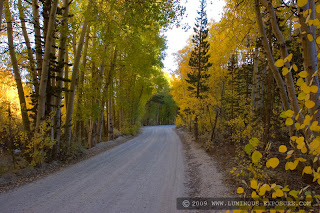
After North Lake and the area's around there, I went up to Lake Sabrina. Some good color here.
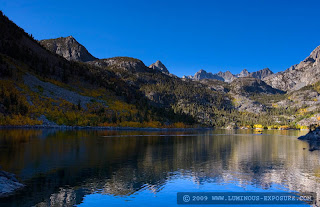 After this area the sun was up pretty high and the photography wasn't as good, so we returned to the campground in Rock Creek. The trees in East Fork Campground were half yellow half green. The trees above Rock Creek Lake were peaking or past peak. Some of the leaves already fell off the trees. But there was good color here and there.
After this area the sun was up pretty high and the photography wasn't as good, so we returned to the campground in Rock Creek. The trees in East Fork Campground were half yellow half green. The trees above Rock Creek Lake were peaking or past peak. Some of the leaves already fell off the trees. But there was good color here and there.Panoramic of Rock Creek Lake
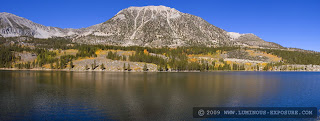
Panoramic of Rock Creek between the lake and Mosquito Flat

We left later in the afternoon to head home. On the way I stopped at Convict Lake and took this shot. There's a little color here but it's got a way to go yet.
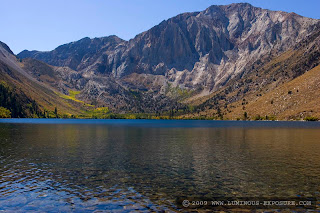
You can see the rest of the photos from our trip on my Flickr album.
http://www.flickr.com/photos/42490701@N05/sets/72157622343043947/
You can see my other photography at my website.
www.luminous-exposure.com/pics.html
Monday, August 20, 2007
Graduated Neutral Density Filters
The reason for these filters is to bring the light range of the image you are shooting to be more even. Cameras can only capture a finite range of light. We call this stops of light. The human eye can see almost twice the range...also caled Dynamic Range. Picture a scene where the sky is bright, and the ground is dark. The range between the sky and the ground is too drastic to capture in an image. So, this is where the grad ND filter came in. By putting the dark half over the sky, the brightness of the sky is lowered closer to the ground to give an even exposure.
With digital, we can mimick a ND filter using photoshop. First you need a scene to shoot. Shoot the scene with 2 shots of exactly the same frame. Just expose one for the sky, and one for the ground. Once you got this, follow these steps.
Load in the first image, the one shot for sky into photoshop.
Then load in the shot exposed for the ground.
Next select the one exposed for ground, click ctrl-a to select all. then ctrl-c to copy.
Then click on the image exposed for sky and press ctrl-p. This will past the other image on top. You'll see the image has 2 layers now. I highlighted this in magenta.
Next add a layer mask, (make suer the top layer is highlighted in the layers box on the right) The layer mask button is on in the bottom right. You should see a white box appear in the top layer.
Once you have a layer mask, click on the layer white box of the layer mask. Then click the gradient tool, and make sure you have black and white colors selected. Next click and drag the tool, while sholding shift to draw a vertical line. This will fill in one half with black, one half with white, and anything in the range you selected with a gradient in between.
You can now see the layer maks has the black and white in it. Anything in this layer that has black in the mask is invisible, so the layer beneath will show through. White will only show the top layer. Any gray in between will blend depending on how white or black. This is how we get a nice soft edge to the gradient.
The final image looks something like this.
Hope you find this method useful. In situations where the horizon isn't very straight, you may have to use other methods which I'll get into in the future.
Thursday, July 5, 2007
How to Shoot Lightning

My first attempts at lightning go back about 11 years, when I tried to shoot lightning using my reflexes...needless to say nothing came out. Few years later, armed with a better camera, I tried again during a storm, and only got a few keepers. Either my reflexes got better, or I was lucky.
It made me realize there must be a better way to shoot lightning...after some research and thought, I learned the secret...and today I'll share the secret to getting lightning shots like this:
You'll need a few tools to shoot lightning. One is a good camera, preferably a digital SLR. Although film SLR will work, as well as some point and shoot models (One that allows longer shutter speeds). You'll also need a tripod to keep the camera steady. And the final item, is a cable release...this will greatly increase your ability to shoot lightning.
Here are the steps to follow for shooting lightning (These are based on using a digital SLR, other cameras would be similar):
- Start with a wide angle lens to cover more sky area, this will give you a better chance of getting lightning.
- Set the camera up on a tripod facing an area you think lightning will strike. Sometimes it's good to include some ground for a reference in the shot.
- Set the aperture to around F5.6 to F8, and the ISO to around 100 or 200.
- Set your shutter speed to 4 seconds. You can go longer if you want, you may have to play with the settings to get a good exposure.
- If your camera has long exposure noise reduction, turn it off. How this feature works, is it takes a dark frame (shutter closed) after the regular frame, and subtracts it. The problem with this is the dark frame takes the same amount of time, so a 4 second exposure, takes 4 seconds of exposure, and 4 seconds of dark frame. And it's during those 4 seconds it's doing the dark frame that lightning will strike if your as lucky as me. =)
- Focus the image. If you can get auto focus to work, that's fine, but once it's in focus switch to manual so the focus doesn't change (or delay exposures)
- Set the camera to continuous shooting mode.
- Use the cable release to start shooting. Some cable releases, have a lock that will hold the shutter button down. This will make the camera continually shoot non stop, until the digital media card (Compact Flash, etc) is full.
- If lightning strikes any time during the exposure, you will capture it.
- Once you are finished, delete any of the "bad" images. Keep all the ones with lightning on them. This is where digital has the advantage...with film, you waste a lot of film to only get a few shots. If you are using film, try lengthening the exposure time to 15-30 seconds. This will use less film.
One thing to understand is lightning is EXTREMELY bright, and it flashes really fast. The length of the flash is all you need for exposure, since the area is mostly dark, the long exposure won't show much, except lightning when it flashes.
Finally, the most important thing of all. Don't risk your life. Lightning strikes kill. If you think the storm is getting to close, leave the area.
Good luck, and if you're lucky you may come out with some great lightning shots.



